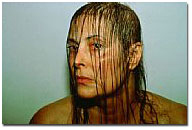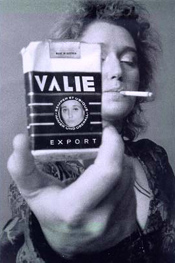Part of Fall 1999
Layers of symbolic meaning fat every woman’s flesh. Cosmetic surgery, computer mediated self-knowledge and highly stylized rituals of public display are the subjects of the various works in + Flesh. The centre piece of the programme is French performance artist Orlan’s shocking documentation of her ongoing project, The Reincarnation of Saint Orlan. Combined with the digitally mediated works of videomakers Texas Tomboy and Kristin Lucas, the programme provides both back and front views of the female body’s augmentation by technology and technique. The key visual component that the works share is one of artificiality, a place filled with images that are theatrically staged and technological manipulated. Thematically they join together in raising questions about who, or what, we are within this cultural space of the cyborg or post-human body.
Biographies:
Kristin Lucas has been recognized as one of the most exciting of a new generation of young artists working in video, installation and performance. Writes Lucas: “As a woman, I am creating a discourse within which to elucidate my relationship toward the electronic dream. I unravel the complexity of this relationship by setting up virtual interactions with mediated devices, such as automated tellers, public access television, computer games, and the World Wide Web.” Lucas uses her camera as a diaristic device, into which she unloads her anecdotal, performative mini-dramas. Her work resonates with a sense of social isolation and alienation from the computer/television/electronic media that she posits as a surrogate for personal interaction. The backdrop to Lucas’s work is the empty world of daytime television, cable shopping channels and shopping malls. Kristin Lucas graduated from The Cooper Union School of Art, in 1994. She has participated in festivals and exhibitions in the US and abroad since 1996, including: Young and Restless at the Museum of Modern Art, the 1997 Whitney Biennial, the Brooklyn Museum of Art, New York; The Nelson-Atkins Museum of Art, Kansas City, Missouri; steirischer herbst 9, Graz, Austria; the Semaine Internationale de Video, Geneva, Switzerland; Stedelijk Museum, Amsterdam; and at Dunedin Public Gallery, New Zealand. In August 1998 Lucas launched her first web project, Between a Rock and a Hard Drive with Dia Center for the Arts at http://www.diacenter.org/lucas/. She lives in New York.
From the 70s until her death in 1993, Hannah Wilke produced work that examined sex and sexuality, feminism and femininity, the body and its representation. Working in sculpture, painting, performance, video, and photography, Wilke often used her own body as a means of asserting a specifically female iconography. Wilke’s project culminated in the early 90s with a stark, moving series of photographs of her face and body during her struggle with cancer. In the 70s and early 80s Wilke made a series of performance videotapes, in which she often explored issues of gender and power through posturing, posing, and gesture. Other tapes document her performances, such as Through the Large Glass, in which she performs a striptease behind Duchamp’s The Bride Stripped Bare by Her Bachelors, Even at the Philadelphia Museum of Art. Wilke uses her own image to confront the erotic representation of the female body in art history and popular culture. Wilke was born in 1940 and studied at the Tyler School of Art, Philadelphia. Wilke received awards from the National Endowment for the Arts, the Pollock Krasner Foundation, and the John Simon Guggenheim Memorial Foundation. Her work has been included in exhibitions at the Museum of Contemporary Art, Los Angeles; Centre Georges Pompidou, Paris; Museum Ludwig, Cologne, and the Whitney Museum of American Art, New York. Wilke has had solo exhibitions at the PS1 Institute and Ronald Feldman Fine Arts in New York, and the Nikolaj Contemporary Art Center, Copenhagen.
Dara Birnbaum’s provocative video works are among the most influential and innovative contributions to the contemporary discourse on art and television. In her videotapes and multi-media installations, Birnbaum applies both low-end and high-end video technology to subvert, critique or deconstruct the power of mass media images and gestures to define mythologies of culture, history and memory. Through a dynamic televisual language of images, music and text, she exposes the media’s embedded ideological meanings and posits video as a means of giving voice to the individual. Birnbaum has stated that she wanted to “define the language of video art in relation to the institution of television.” In her radical media critiques of the late 70s, including the seminal Technology/Transformation: Wonder Woman (1978-79), she used rigorous tactics of deconstruction and appropriation to dismantle television’s codes of representation. Among the first artists to apply these strategies to subvert the language of television texts, she turned its vocabulary back on itself in a powerful critique. Analyzing TV’s idiomatic grammar (reverse shot, cross-cut, inserts) and genres (game shows, sitcoms, crime dramas), she recontextualized pop cultural icons Kojak, General Hospital through fragmentation and repetition. She writes: “By dislocating the visuals and altering the syntax, these images were cut from the narrative flow and countered with musical texts, plunging the viewer headlong into the very experience of TV unveiling TV’s stereotypical gestures of power and submission, of self-presentation and concealment, of male and female egos.” These groundbreaking works often focus on the representation of women. In the mid-80s, Birnbaum began exploring the metaphorical and expressive potential of video technologies. In the Damnation of Faust trilogy, she rearticulates the Romantic Faustian myth through a female voice, as a catalyst for introspections into the conflict between inner and external worlds, loss and memory. Drawing on her background in architecture and painting, she invents new pictorial devices to extend her evocative narrative content. Actual and psychological reality, past and present are conjoined through visual motifs such as reframed and layered images, dramatic wipes, and box inserts that function as windows onto other realities. In Canon (1990), she merges low-end and high-end technology to explore how the individual’s voice can be heard in a technocratic society. Birnbaum has received international recognition for her installation works, from the widely exhibited PM Magazine (1982-89), a powerful deconstruction of television’s visual economy of sexuality and consumerism, to Tiananmen Square: Break-In Transmission (1990), an examination of the role of the media in the Chinese student uprisings. Exploring how technology and media function in culture through a collusion of art and television, Birnbaum has produced works for contexts ranging from public sites to MTV. In 1989, she completed the Rio Videowall, a permanent large-scale outdoor video installation, a twenty-five-monitor interactive wall at Rio Shopping/Entertainment Complex in Atlanta, Georgia. Birnbaum was presented with the American Film Institute’s Maya Deren Award for Independent Film and Video in 1987. She also received the Louis XIII de Remy Martin Award of Excellence in 1987, and was appointed Visiting Junior Fellow of the Council of the Humanities and Perkins Junior Fellow in the Program in Visual Arts at Princeton University. In the same year, she produced an Artbreak for MTV Networks, Inc., and Rough Edits: Popular Image Video, a book on her early videoworks, was released. Birnbaum received Harvard University’s Certificate in Recognition of Service and Contribution to the Arts as Visiting Artist 1987-88, and a Louis B. Mayer Artist-in-Residency at Dartmouth College in 1983. She has received numerous grants and awards for her work in video, from institutions including the National Endowment for the Arts; the New York State Council on the Arts; and Creative Artists Public Service (CAPS); as well as contributing monies from the Contemporary Art Television (CAT) Fund; WNET/WGBH-TV; and Art Matters, Inc. International solo exhibitions of her work include the Museum of Modern Art, Whitney Museum of American Art and Josh Baer Gallery, New York; IVAM Centre Julio Gonzalez, Valencia; and the Muse d’Art Contemporain, Montreal. Retrospective screenings include the American Film Institute, Los Angeles; Kunsthaus, Zurich; and Kunstmuseum, Berne, Switzerland. Birnbaum was the only video artist invited to participate in Documenta 7, Kassel, Germany; the 1985 Carnegie International, Pittsburgh; and the 74th American Exhibition, Chicago, where she was awarded the Norman Wait Harris Prize. Birnbaum’s international group exhibitions include Moderna Museet, Stockholm; Stedelijk Museum, Amsterdam; Tate Gallery, London; Centre Georges Pompidou, Paris; Hirshhorn Museum and Sculpture Garden, Washington D.C.; Institute of Contemporary Art, Boston; New Museum of Contemporary Art, New York; Museum of Contemporary Art, Los Angeles; Centre Audiovisuel Simone de Beauvoir, Paris; Neuer Berliner Kunstverein, Berlin; and DuMont Kunsthalle, Cologne. She has taught at the Nova Scotia College of Art and Design, Halifax; California Institute of the Arts, Valencia; Princeton University; and the School of Visual Arts, New York. She received a Bachelor of Architecture degree from Carnegie Institute of Technology and a BFA in painting from the San Francisco Art Institute. Birnbaum lives in New York.
Austrian-born Valie Export is an artist, independent filmmaker, and theoretician who has created works in a variety of media, including documentary and narrative film, video, performance, photography, installation, sculpture, and drawing. Regarded as one of Europe’s most influential feminist filmmakers, and a central figure in the Austrian conceptual and avant-garde film movements since the 60s, Export is renowned for her early risque, guerrilla performances.
A Perfect Pair, Valie Export, 14:00, 1987
A Perfect Pair posits the idea that individual consumers are walking billboards for the products they use, with product slogans and brand names peeking out from every crevice and cranny of the actors bodies. Export here demonstrates how the body of the consumer, especially that of the female consumer, is co-opted by commercialism. In tongue-in-cheek fashion, A Perfect Pair celebrates the modern-day co-mingling of fetish objects, as a body builder seduces a prostitute at a bar saying, Your eyes are the most beautiful blue ad-space, your cheek could promote a Mercedes, your neck could be a slogan for styled technology. Export’s work is centered around the evolving role of women in a culture where images increasingly displace material reality. A Perfect Pair wonderfully illustrates the inescapability of advertising regime of signs, the signifying network of personal/product values that is effectively encoded on the space of women’s bodies.
Kathleen Pirrie Adams is a writer and curator who focuses on experimental film and video, new media art, popular music, and sexual styles and histories. She has published in Fuse, Alphabet City, Rungh, Xtra!, Coil, and Mix and is currently working on a book entitled Pornapology: Explicit Imagery in Contemporary Art. She is the Programme Director at InterAccess
Electronic Media Arts Centre in Toronto. Also an occasional filmmaker, Pirrie Adams has directed Close Watch and Venus Church and co-directed Excess Is What I Came For. Her essay titled Lady in the Lake: Fluid Forms of Self in Performance Video was recently published by YYZ Books in conjunction with Promise, an exhibition that included the work of Pipilotti Rist held at YYZ Artists’ Outlet in October, 1999.


